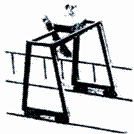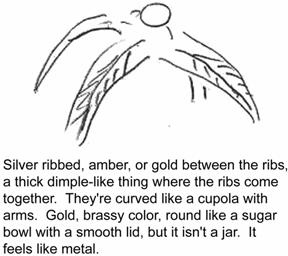People Can See, Hear, Smell, Taste, and Touch Without Using the Brain
There is a community of the spirit.
Join it, and feel the delight….
Close both eyes
To see with the other eye.
– Jelaluddin Rumi (Muslim Sufi mystic)
If we are aside from and greater than the body, then you’d think we could learn some things about the world without using the body. In other words, if someone could prove that we can see without using our eyes, then that would mean the eyes, retina, optic nerve, and optical cortex in our brains aren’t necessary for us to be able to see; they’re just options the mind uses in the physical realm.
But seeing without using the eyes is very common today. Thousands of people are able to see without using their eyes using a very common ability called “remote viewing.” The remote viewer sits quietly with his or her eyes closed and focuses on something hundreds or thousands of miles away. The remote viewer is able to see it. Not only that, but the person is often able to hear it, smell it, feel the texture, sense movement, and sense emotions involved with it. In other words, the person is doing things outside of the body while the body is sitting quietly with its eyes closed.
The Government Found Remote Viewing Is Valid.
For several decades at the end of the twentieth century, the CIA had a remote viewing program named Operation Stargate that attempted to use remote viewers to spy on the Russians. The program had remarkable results. In 1974, a remote viewer named Pat Price was to view a mysterious, unidentified research center at Semipalatinsk, USSR, to see what was there. He sat with his eyes closed and focused on the area. Below is his sketch of what he saw in his mind. It had all the distinguishing marks of a gantry crane.
Later, the CIA obtained satellite photos of the site. A CIA artist created the following sketch of part of the site based on photos of the actual Semipalatinsk site. It was a gantry crane:
Government Verification Study: Stanford Research Institute (SRI)
The government wanted to be sure that their investment in remote viewing was going into a valid enterprise, so to find out whether people can really view things from a distance using remote viewing, the government agencies commissioned the Stanford Research Institute (SRI) to perform 154 experiments with 26,000 separate trials over 16 years. At the end of that testing period, Edwin May, Ph.D., a researcher in low energy experimental nuclear physics, headed a team of researchers that analyzed the experiments and reported to the government.
They concluded that the odds against someone merely guessing what remote viewers had described when focusing on a target at a distant location, was more than a billion billion to one. His only explanation was that they genuinely were seeing without using their eyes and without regard for how many miles away the target was.
Government Verification Study: SAIC
Now satisfied that remote viewing existed, the government sponsors of the remote viewing activity requested a second evaluation to find out how it works. Congress and the CIA commissioned a study by the Science Applications International Corporation (SAIC). The result of the study was that Jessica Utts, professor in the Division of Statistics at the University of California at Davis, prepared a report assessing the statistical evidence for remote viewing in U.S. government-sponsored research. She uses the term “anomalous cognition” to refer to remote viewing. This is her conclusion:
“It is clear to this author that anomalous cognition is possible and has been demonstrated. This conclusion is not based on belief, but rather on commonly accepted scientific criteria. The phenomenon has been replicated in a number of forms across laboratories and cultures. The various experiments in which it has been observed have been different enough that if some subtle methodological problems can explain the results, then there would have to be a different explanation for each type of experiment, yet the impact would have to be similar across experiments and laboratories. If fraud were responsible, similarly, it would require an equivalent amount of fraud on the part of a large number of experimenters or an even larger number of subjects. . . .
I believe that it would be wasteful of valuable resources to continue to look for proof. No one who has examined all of the data across laboratories, taken as a collective whole, has been able to suggest methodological or statistical problems to explain the ever-increasing and consistent results to date. Resources should be directed to the pertinent questions about how this ability works. I am confident that the questions are no more elusive than any other questions in science dealing with small to medium sized effects, and that if appropriate resources are targeted to appropriate questions, we can have answers within the next decade.”
Credible Sources Involved in Government Remote Viewing Projects Agreed It Occurred as Described.
Victor Zammit summarized statements from some government sources who had been involved in the Operation Stargate remote viewing project from Jim Schnabel’s book:
“I never liked to get into debates with the skeptics, because if you didn’t believe that remote viewing was real, you hadn’t done your homework.” — Major General Edmund R Thompson, U.S. Army Assistant Chief of Staff for Intelligence, 1977-81, Deputy Director for Management and Operations, DIA, 1982-84
“You can’t be involved in this for any length of time and not be convinced there’s something here.” — Norm J., former senior CIA official who tasked remote viewers
“There were times when they wanted to push buttons and drop bombs on the basis of our information.” — Dr. Hal Puthoff, a former manager of the CIA remote-viewing program
“She went into a trance. And while she was in the trance, she gave us some latitude and longitude figures. We focused our satellite cameras on that point, and the lost plane was there.” — Former President Jimmy Carter, recalling a 1978 remote-viewing operation
Repeated Research Studies Demonstrated Remote Viewing’s Validity.
The Princeton Engineering Anomalies Research (PEAR) Laboratory at Princeton University began conducting its own, independent studies of remote viewing in 1978. They tested remote viewers by having a person travel to some distant location undisclosed to the remote viewer and having the remote viewer attempt to identify details about the location. The remote viewers in 334 trials were able to describe details about where the person was with odds against guessing the details of the location of 100 billion to 1.
In another study, Robert Jahn, former director of the PEAR Lab, and psychologist Brenda Dunne conducted 336 rigorous trials with 48 ordinary people who were asked to do remote viewing at distances ranging from five to 6,000 miles. Almost two-thirds of the results exceeded chance levels, with odds against chance being one billion to one.
Russell Targ, a physicist who pioneered development of the laser, and Harold Puthoff, another physicist who wrote the widely read Fundamentals of Quantum Electronics, conducted experiments on remote viewing to determine whether the phenomenon was real. In their tests, they had a person whom they called a “beacon” travel to a distant site to see whether a remote viewer could receive mental impressions about the site. The beacon and remote viewer were separated by distances of several miles so there could be no communication between them, and the beacon was instructed to go to a site randomly chosen by Targ and Puthoff without the remote viewer’s knowledge. The remote viewer was to then focus on the beacon trying to get impressions about where the beacon was and writing or sketching the scenes. This is a summary of their findings:
Independent judges found that the descriptions of the sketches matched on the average 66 percent of the time the characteristics of the site that was actually seen by the beacon.
These findings were far beyond chance, demonstrating that the receiver was looking at the scene where the sender was while many miles away.
Dr. Chris Roe, a parapsychologist at the University of Northampton in the UK also verified remote viewing’s validity through his studies. When the results were reviewed by Dr. Brian Josephson, a Nobel Prize-winning physicist from Cambridge University, he concluded, “The experiments have been designed to rule out luck and chance. I consider the evidence for remote viewing to be pretty clear-cut.
I Can See without Using My Eyes.
I’m especially able to see objects someone puts on a table or desk anywhere in the world. I can sit in my office, close my eyes, and focus on the place where the object is. In the blackness of my mind, I can begin to get images of the object and impressions about it. I then write a description of the object and sketch it (although I’m not much of an artist).
In 2005, I corresponded with a computer systems analyst in New Jersey named Bill Walker about remote viewing. He asked me to do some sessions for him to show him what it is like. I sat in my office in Illinois, closed my eyes, and focused on objects he had set up in New Jersey. I e-mailed my impressions and sketches to him. Some accurately described the objects he had in his office and house, so he decided to put my remote viewing sessions on his Web site. I’ve reproduced them on the pages that follow to illustrate that we don’t need a body to see things hundreds of miles away. You can see his Web site by going to the link at http://youreternalself.com/chapter1.htm.
This is his description from the Web site of how the sessions occurred:
Craig Hogan and I communicated only via email. He lives about 700 miles away from me. All he knew about me was my name, email address, and that I lived in New Jersey. I would place an object on my table and Craig would email me his impressions. He said that he often got impressions of other objects in the room. His only input was an object on Bill Walker’s table. The impressions included sketches and sometimes written descriptions. In between sessions, the only feedback I gave to him were the photos of matched items that I show below [on his Web site]. For each session, he gave anywhere from 5 to 20 impressions.
In the first session, Bill Walker told me he would put an object on the table in his office. When I was ready to view the object that was the “target” on his table, I sat in my office in Illinois and closed my eyes. I focused on seeing things “on Bill Walker’s table.” In a few seconds, I did see a green light shining down on gold brassy parts and sent my notes to him, along with my sketches of what I saw. He responded to my notes telling me that the green light was his banker’s lamp with a green shade and gold bottom about six feet from the table in his office. The other sketches didn’t match things in the office.
However, when he arrived home, he found that I had been sketching things on the tables in his home, not his office. The sketches, my descriptions, and the photographs he sent me after I sent him my sketches are on the pages that follow.
The First Session–An Orb
Below is the sketch of an orb I sent to him attached to an e-mail. The text I sent in the e-mail follows the sketch.
My sketch perfectly matched an orb on a table in his home. He made a photograph of the orb and put it on his Web site. The photograph is below the sketch. The object is made of metal, and he described the color in this way: “in natural light, the orbs do have both silver and gold colors.”
A Second Session–A Plant with Round Balls on It
We did other sessions focusing on things on tables in his home, since it appeared my mind wanted to look at tables there. I knew nothing about the objects except that they were on tables in Bill Walker’s home. I sat in my office in Illinois focusing on “a table in Bill Walker’s home,” and saw in my mind a plant with large leaves and odd little balls at the ends of the stems. I e-mailed the sketch below. In the e-mail, I wrote “like stems, organic” and “looked like two leaves, with some stems that had small circles on the end of them.” Below the sketch I sent is a photograph he then sent to me of the plant on a table in his house.

A Third Session–A Peach-Colored Flower in a Pot
I closed my eyes again to look for “things on a table in Bill Walker’s house” and saw another plant that had a light peach flower on it. I sketched the pot, two leaves on the sides, and a flower in the middle that I saw as “light peach.” The sketch is below. I sent the description and sketch to him. He returned the photograph of a plant on a table in his house that appears at the bottom of this page. The flower is light peach.
A Session for Rick Stewart in Maryland
I did another remote viewing session for Rick Stewart, a man I had never met before, who lived in Maryland. I viewed the object from my office in Illinois by closing my eyes and focusing on the object. This is the description I wrote in my e-mail to him and the sketch I sent:
First drawing round thing, two feet-like things out front and round thing on top, like a toy, yellow/green color. I know there was something white somewhere on it but I forgot where by the time I sketched what I could get.
Another view after writing my notes and closing my eyes again] Got another round thing. This is rather like a doll, but it doesn’t seem like a doll. It’s more like a rolly-polly thing with a body and feet.
I sent it to Rick Stewart in Maryland. He returned the photograph of the target object that is at the top of the next page. Its color is yellow green and the pinwheel on the front is white.
I can do this at any time, with accurate descriptions like these examples around 60% of the time. It isn’t just a one-time happening.
No photons came through my corneas to strike my retinas and create electrical pulses that would travel along the optic nerve to my brain. There are no sensory input devices on my body that would receive photons from 800 or 900 miles away, and without photons, an image of the object organized into a pattern with billions of pieces to match the photons would have to all travel together to where I was sitting. Something would have to encode the image (like a camera or retina), then transmit the image. There was nothing like that involved. Electromagnetic energy could not travel that far over the horizon, and studies of remote viewing with the viewers in rooms shielded by lead to block out energy (Faraday cages) show that the remote viewing is just as clear when no energy could possibly come to the viewer.
The blob of fat and protein trapped inside the darkness of my skull couldn’t possibly have seen a rolly-polly doll or plants on tables hundreds of miles away; but I saw them. Or rather, my mind, which is outside of my brain, saw them.
The ability to remote view is very common among people. There are clubs that do remote viewing, such as the very active, proficient group in Hawaii named the Hawaii Remote Viewers Guild that does remarkable, consistently accurate remote viewing for entertainment. The links to some of these remote viewing groups, including the Hawaii group, are at http://youreternalself.com/chapter1.htm
One estimate is that one out of a hundred people can do remote viewing successfully, meaning that among the 260 million people of all ages in the United States, 2.6 million can or will be able to do remote viewing. I am able to do it. I, and all of the many other people now doing remote viewing easily, at will, are able to close our eyes and intend to see something hundreds or thousands of miles away with nothing more to guide us than a location or a number assigned to the object or picture. Images come to our minds, but they aren’t coming through our eyes.
You can try remote viewing by taking the test I have online at http://youreternalself.com/chapter1.htm
What Remote Viewing Means for Where You Are
The data showing that remote viewing is a common phenomenon are overwhelming. It shows without question that people can sit quietly with their eyes closed and “see” things hundreds or thousands of miles away, in places they’ve never been.
That means that the mind isn’t in the brain. It isn’t trapped inside the bony encasing of a skull. When people see using eyes, photons (light particles) come through the eye and travel along the optic nerve to the brain. In remote viewing, there is no opening in the skull for images to come in. There is no light energy coming from thousands of miles away. We can remote view objects inside dark boxes and envelopes. Studies of remote viewers in lead-lined rooms show that they still get images, so no electromagnetic signals (light, radio waves, infrared waves, microwaves) are involved. There is no energy that carries the image. The remote viewer sees instantly, regardless of distance.
What all that means is that the mind that does the seeing is outside of the brain and is linked with the object that is far away. The spirit doesn’t travel to the object. There is no geographical distance where the mind is. We are one with everything in the universe, including other people’s minds.
You aren’t in a brain. Your mind is outside of the brain.
Learn how to here.
Read more here:
http://youreternalself.com/chapter1.htm












